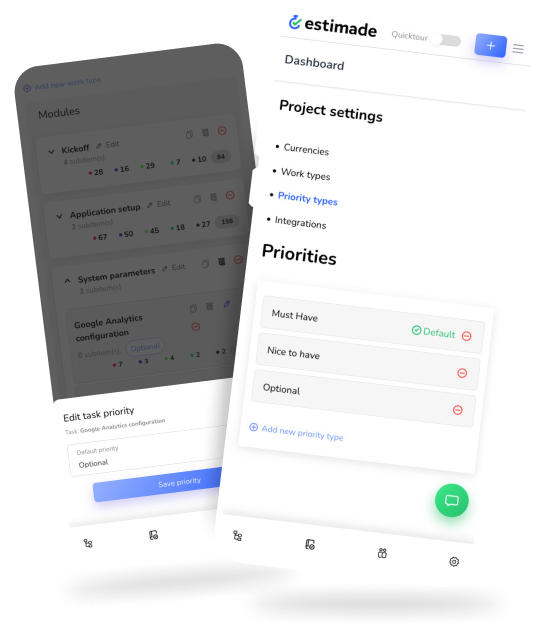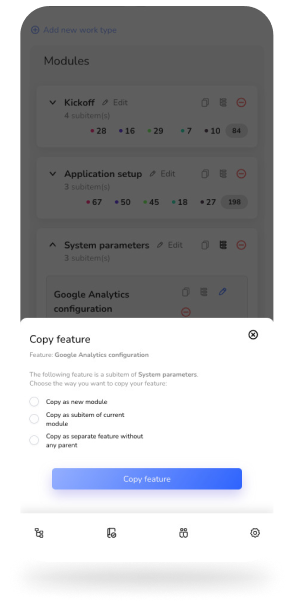Services library
The service catalog is one of the basic functions of Estimade. It is in it that all the recurring services you provide should be listed. In Estimade, such a library is the basis for all newly created estimates. If you find that your estimates for repetitive tasks need to be adjusted, simply change the corresponding values in the service catalog. From now on, all your new estimates containing the modified task will have the corrected values.
Prioritize your tasks
We created Estimade to make its use as flexible as possible. Therefore, when creating new services (functions), we included the possibility of assigning priorities to their implementation. Thanks to this, the customer already at the stage of valuation knows which services in your offer will be obligatory, and which he can postpone or completely reject (for example, due to limited budget).

Create new tasks based on existing ones
Building a catalog of services is a process that is carried out successively as your business grows. So it often happens that some service is the basis for creating a new, much more refined one. That's why at Estimade we have provided a duplicate task function. We developed the cloning so that you have full flexibility in creating catalog elements - so you can create modules from tasks, functions from modules, and so on. Full freedom - exactly as you need it.

Accelerate the creation of your offers today!
Build complex services by dividing them into modules, tasks and subtasks
Knowing that the labor intensity of the company's services can be as much as several thousand hours, we made it possible to build the catalog by modules, functions (features) and tasks (tasks). We built the elements of the catalog in a hierarchical manner, i.e.:
- Modules - the most general services, which consist of more detailed functions. In the catalog of services, it is possible to give a name to a module and assign sub-elements to it.
- Functions - services that may (but need not) contain subordinate tasks. If a function does not have subordinate tasks, it is possible to define its labor intensity for each of the service categories present in the system. If, on the other hand, the function has subordinate tasks, its labor intensity is calculated separately for each category as the sum of the category from the subordinate tasks. A distinctive feature of the function is the ability to specify the priority of its execution, such as presenting the service in the quotation as a necessary task to be performed.
- Tasks - the most detailed elements of services. Tasks should be created mainly with a view to creating a full "checklist" in more complex functions. With this approach, you are assured that a given service will contain all the key activities necessary for its implementation. Breaking down the service into the simplest possible activities also significantly reduces potential problems with underestimating the performance of the service.
Define the labor intensity of tasks by service category
When you get access to the application, in the first steps you define, among other things, the categories of services that your company provides. Each service that will be included in your future quotes will be priced precisely based on the labor intensity in that category.
Example 1: Building a website will require work in at least the following categories: Design, Frontend, Backend, Project Management. So if you are dealing with these types of services, these may be your initial categories. Over time, you can think about categories such as SEO, Marketing, etc., adding them to the system.
Example 2: Designing a garden for your client, will require work from a number of diverse categories: from the initial work, where you need to gather all the information, to the design work, to doing the calculations, to supervising the contractors. These categories can therefore form the basis for creating quotes in the system for a landscape architect's business.
In Estimade, the services in the catalog (and backlog) are priced based on man-hours for each of the defined categories. But what if there are categories whose labor intensity depends on the workload of other categories?
Automatic category calculations - when the amount of your work depends on the work of others
Imagine that you are a manual tester and your job is to execute test scenarios of the implemented project. You probably realize that the number of scenarios to be tested is correlated with the number of functions performed by other teams (e.g. developers).
At Estimade, we have provided a solution that allows you to create automatic calculations based on the labor intensity of other categories. All you have to do is specify the percentage and select the categories on the basis of which the labor intensity of your tasks should be calculated and.... done!
Try Estimade free for 14 days!